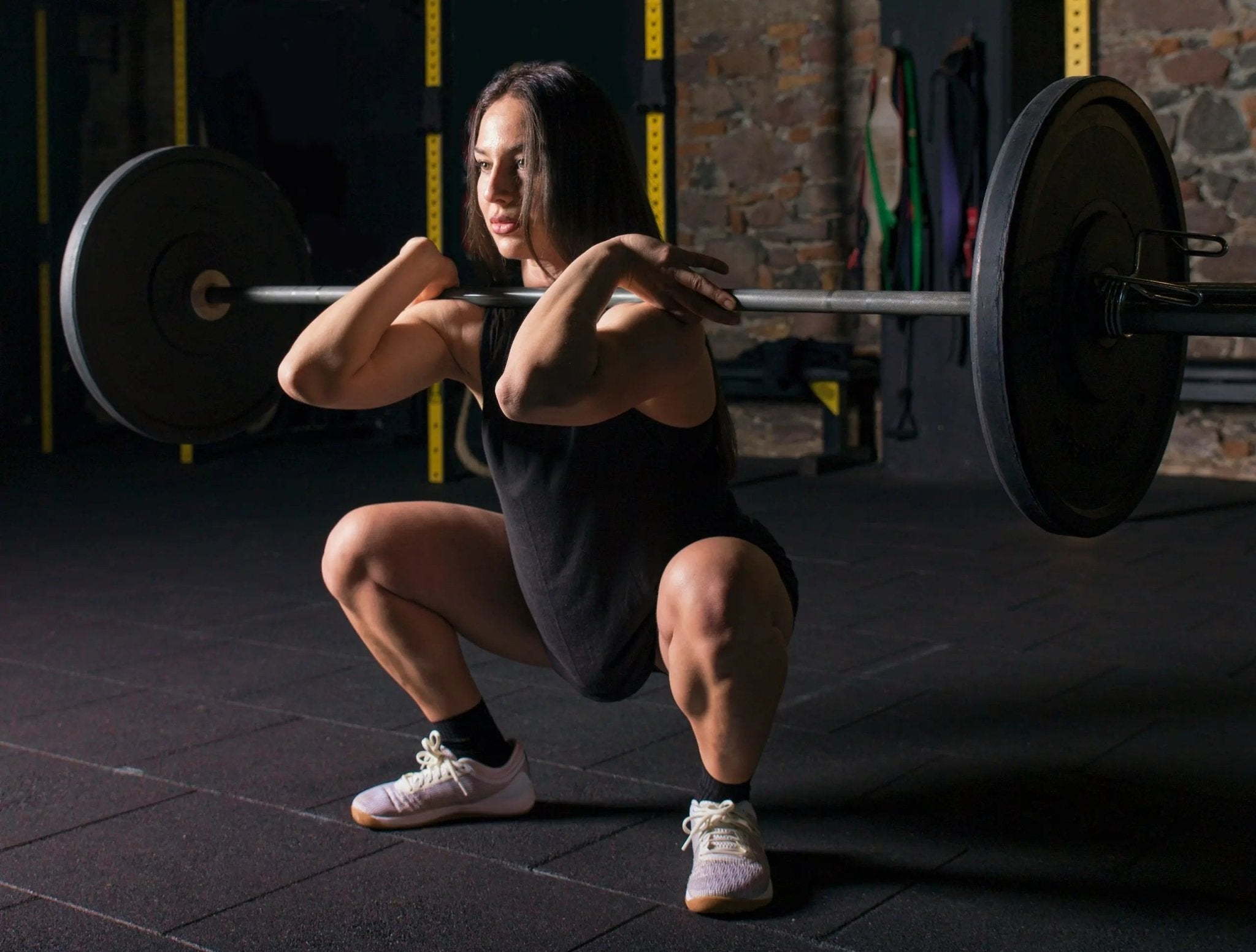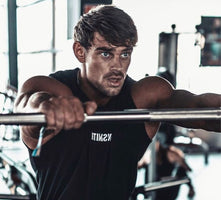
Barbell Front Squat: Build Your Quads With Proper Form
The front squat is a popular variation of the traditional squat exercise that targets the lower body muscles, including the quadriceps, hamstrings, glutes, and core. Unlike the back squat, the front squat involves holding the barbell in front of the body, resting on the shoulders and collarbone. This unique position requires more upper body strength and mobility, making it a challenging movement that yields great benefits.
One of the primary benefits of the front squat is its ability to improve overall leg strength and muscle development. By placing the barbell in front of the body, the exercise places greater emphasis on the quadriceps, resulting in more significant muscle activation and growth. Additionally, the front squat engages the primary muscles to a greater degree than the back squat, helping to improve overall core strength and stability.
Despite its many benefits, a favourite of the crossfit community and bodybuilders worldwide, the front squat can be a challenging exercise to master, requiring correct form and technique to avoid injury. However, with the right guidance and practice, anyone can learn to perform the front squat safely and effectively, reaping the rewards of this powerful exercise.

Understanding the Front Squat
The front squat is a popular exercise that targets the lower body, particularly your quads, glutes, and hamstrings. It is a variation of the traditional squat exercise that involves holding the barbell in front of the body instead of on the upper back. This position requires greater core stability and upper body strength, making it a challenging exercise that can yield significant benefits.
To perform a front squat, the barbell is held in the front rack position, with the elbows pointing forward and the hands gripping the bar. The feet are shoulder-width apart, and the knees are bent to lower the body into a squat position. The hips are pushed back, and the torso is kept upright throughout the movement. The squat is completed by standing up, barbell positioned at the front of your body, across the front side of your shoulders, lower into a squat then returning to the starting position.
One of the primary benefits of the front squat is its ability to strengthen the quads and glutes. This is due to the position of the barbell, which places greater emphasis on the front of the legs. Additionally, the front squat can help improve core stability, balance, and coordination. It also requires greater mobility in the ankles, hips, and shoulders compared to other lower body movements, making it a great exercise for improving flexibility.
When performing the front squat, it is important to maintain proper form to prevent injury and maximize the benefits of the exercise. This includes keeping the elbows up and the chest lifted, maintaining a neutral spine, and keeping the knees in line with the toes. It is also important to start with a lighter weight and gradually increase the weight as strength and technique improve.
Overall, the front squat is a challenging yet effective exercise that can help improve lower body strength, core stability, and flexibility. With proper form and technique, it can be a valuable addition to any workout routine.
Proper Form and Technique
Front Squat 101 - To perform a front squat with proper form and technique, it is important to pay attention to several key elements. These include grip and rack position, foot position and stance, torso and spine alignment, and lower body mechanics.
Grip and Rack Position
The grip and rack position are crucial for maintaining proper form during the front squat. The lifter should grip the bar with their fingertips, using a clean grip or a cross grip. The bar should rest on the front delts, with the lifter's elbows pointing forward and up. The fingertips should be under the bar, with the bar resting on the shoulders.
Foot Position and Stance
The foot position and stance are important for maintaining balance and stability during the front squat. The feet should be shoulder-width apart, with the toes pointing slightly outward. The lifter should stand in front of the squat rack, with the bar resting on the front delts.
Torso and Spine Alignment
The torso and spine alignment are crucial for maintaining proper form and preventing injury during the front squat. The lifter should keep their torso upright and their spine neutral, with their chest up and their shoulders back. The lifter should also engage their core muscles to maintain stability and support their lower back.
Lower Body Mechanics
The lower body mechanics are important for maintaining proper form and maximizing the benefits of the front squat. The lifter should initiate the squat by pushing their hips back and down, while keeping their knees in line with their toes. The lifter should also push through their heels to stand up, while keeping their core engaged and their torso upright.
Overall, proper form and technique are essential for performing the front squat safely and effectively. By paying attention to grip and rack position, foot position and stance, torso and spine alignment, and lower body mechanics, lifters can maximize the benefits of this challenging exercise.
Muscles Worked in Front Squat
Front squat is a compound exercise that targets multiple muscle groups in the body. It is a great exercise for building lower body strength and power. Here are the main muscles worked during the front squat:
-
Quadriceps: The front squat primarily targets the quadriceps muscles, which are located at the front of the thigh. This muscle group is responsible for extending the knee joint and straightening the leg.
-
Glutes: The gluteus maximus, medius, and minimus muscles are also activated during the front squat. These muscles are located in the buttocks and are responsible for hip extension and rotation.
-
Hamstrings: The hamstrings are located at the back of the thigh and are responsible for knee flexion and hip extension. They are also activated during the front squat.
-
Lower Back: The erector spinae muscles, which run along the spine, are activated during the front squat. These muscles help to keep the back straight and stable during the exercise.
-
Abs and Obliques: The abdominal muscles and obliques are also activated during the front squat. They help to stabilize the core and maintain proper form during the exercise.
-
Deltoids: The anterior deltoids, which are located at the front of the shoulders, are also activated during the front squat. They help to stabilize the barbell during the exercise.
In addition to these muscles, the front squat also works other muscles in the legs and lower body, including the adductors, calves, and hip flexors. It is a great exercise for building overall lower body strength and power.
Front Squat Variations
Front squats are a challenging and highly beneficial exercise for lifters of all levels. However, there are several variations of the front squat that can be used to target different muscles and provide different benefits.
One variation is the goblet squat, which involves holding a dumbbell or kettlebell at chest level instead of using a barbell. This variation can be easier for beginners to learn and also places more emphasis on the quads. Another variation is the cross-arm front squat, where the lifter crosses their arms in front of their chest to hold the barbell. This can be a good option for lifters who struggle with wrist mobility or discomfort when holding the barbell in the traditional front squat position.
For lifters who want to focus on power and explosiveness, the clean grip front squat is a good option. This variation involves holding the barbell with a clean grip, which can help to improve the lifter's clean and jerk performance. Another option is to use lifting straps to hold the barbell in the front squat position, which can be helpful for lifters who struggle with grip strength.
It's also worth noting that there are several variations of the front squat that can be done with different equipment. For example, the front squat can be done with dumbbells or kettlebells instead of a barbell, or with a safety squat bar to provide a different stimulus to the muscles.
Overall, incorporating front squat variations into a lifting routine can help to target different muscles and provide a variety of benefits. Lifters should experiment with different variations to find the ones that work best for their goals and abilities.
Safety Measures and Tips - Front Squat Form
When performing front squats, safety should always be a top priority. Here are some safety measures and tips to keep in mind:
-
Always warm up properly before lifting weights. This can help prevent injuries and prepare the body for the workout ahead.
-
Wear proper lifting shoes with a raised heel. This can help improve ankle mobility and provide a stable base for lifting.
-
Use proper form when performing the front squat. Keep the core tight, chest up, and knees in line with the toes. Avoid rounding the back or letting the knees cave in.
-
Start with lighter weights and gradually increase as strength and form improve. Don't push yourself too hard too quickly.
-
Consider using lifting straps to help maintain grip on the barbell. This can be especially helpful for those with weaker grip strength.
-
Experiment with different grip variations, such as the cross grip, to find what works best for you. Some lifters may find that one grip feels more comfortable or provides better stability.
-
If you experience any pain or discomfort during the exercise, stop immediately and seek medical attention if necessary.
By following these safety measures and tips, lifters can help reduce the risk of injury and maximize the benefits of the front squat.
Front Squat for Different Levels
Front squat is a compound exercise that targets multiple muscle groups in the lower body, including the quads, hamstrings, glutes, and core. It is a challenging exercise that requires proper form and technique to be performed effectively. Front squat can be modified to suit different levels of experience and fitness goals. Here are some variations for different levels:
Beginner Level
For beginners, it is important to start with the basic front squat technique to avoid injury and build a strong foundation. Here are some tips for beginners:
- Start with bodyweight squats to master the proper form and technique.
- Use a lighter weight or a broomstick to practice the front rack position before adding weight.
- Keep the elbows up and the chest lifted throughout the movement.
- Focus on keeping the knees in line with the toes and the hips back.
- Aim for 2-3 sets of 8-12 reps.
Intermediate Level
Intermediate lifters can add more weight and variations to challenge their muscles and improve their strength and endurance. Here are some tips for intermediate lifters:
- Use a barbell with moderate weight and gradually increase the weight as you progress.
- Experiment with different foot positions, such as a wider stance or a narrower stance, to target different muscle groups.
- Incorporate pauses or tempo changes to increase time under tension and improve muscle activation.
- Aim for 3-4 sets of 8-10 reps.
Advanced Level
Advanced lifters can perform more complex variations of front squats to push their limits and maximize their gains. Here are some tips for advanced lifters:
- Use heavier weights and perform fewer reps to increase strength and power.
- Try different variations, such as the zercher squat or the overhead squat, to challenge your stability and mobility.
- Incorporate plyometric exercises, such as jump squats or box jumps, to improve explosive power and athleticism.
- Aim for 4-5 sets of 6-8 reps.
In summary, front squat can be modified to suit different levels of experience and fitness goals. Beginners should focus on mastering the proper form and technique, while intermediate and advanced lifters can add more weight and variations to challenge their muscles and improve their performance.
Programming and Repetition
Programming and repetition are crucial elements when it comes to building strength and power through front squats. The recommended sets and reps vary depending on the individual's fitness level and goals.
For beginners, it is recommended to start with 3-4 sets of 8-10 reps using a weight that is comfortable to lift. As the individual progresses, they can increase the weight and decrease the reps to build more strength and power.
In powerlifting, the front squat is often used as an accessory exercise to improve the back squat. It is recommended to program the front squat after the back squat, using a weight that is around 60-70% of the individual's back squat one-rep max. This will help to improve the individual's overall squat strength and power.
When programming front squats, it is important to consider the use of pins. Pins are often used to help the individual lift heavier weights without the risk of injury. For example, the individual can set the pins at a certain height and perform partial front squats to build strength in that range of motion.
In terms of repetition, it is recommended to perform the front squat with a full range of motion. This means squatting down until the hips are below the knees and standing back up to full extension. This will help to build strength and power throughout the entire range of motion.
Overall, programming and repetition are important factors when it comes to building strength and power through front squats. It is recommended to start with a weight that is comfortable to lift and gradually increase the weight and decrease the reps as the individual progresses. The use of pins can also be beneficial in building strength in specific ranges of motion.
Comparison with Other Exercises
Front squats are an exercise that can be compared to other exercises such as back squats, deadlifts, bodyweight squats, and Olympic lifts. Each exercise has its own unique benefits and drawbacks, and it is important to understand the differences between them to determine which exercise is best for you.
Back Squats
Back squats are a popular exercise that targets the same muscle groups as front squats. However, back squats place more emphasis on the glutes and hamstrings, while front squats place more emphasis on the quadriceps. Back squats also allow for heavier weights to be lifted, making them a better exercise for building overall lower body strength.

Deadlifts
Deadlifts are another exercise that targets the lower body muscles, but they focus more on the posterior chain muscles such as the hamstrings, glutes, and lower back. Deadlifts are also a compound exercise, meaning they work multiple muscle groups at once. However, deadlifts can be more technically difficult to perform than front squats, and require more equipment such as a barbell and weights.

Bodyweight Squats
Bodyweight squats are a simple exercise that can be performed anywhere, without any equipment. They are a good exercise for beginners or those who do not have access to a gym. However, bodyweight squats do not provide the same level of resistance as weighted squats, and may not be challenging enough for more advanced lifters.
Olympic Lifts
Olympic lifts such as the clean and jerk and snatch are highly technical exercises that require a lot of skill and practice to perform correctly. They are primarily used in Olympic weightlifting competitions and can be beneficial for improving explosive power and overall athleticism. However, they require a lot of equipment and may not be suitable for everyone.
Alternatives
If front squats are not suitable for an individual, there are several alternatives that can be used to target the same muscle groups. Some of the best front squat alternatives include the cross-arm front squat, goblet squat, narrow stance leg press, and dumbbell front squat. Each of these exercises has its own unique benefits and drawbacks, and it is important to choose an exercise that is suitable for an individual's fitness level and goals.
Overall, front squats are a highly effective exercise for building lower body strength and improving overall fitness. However, they should be performed correctly and with proper form to avoid injury. By understanding the differences between front squats and other exercises, individuals can determine which exercise is best for them and incorporate it into their fitness routine.
Nutrition and Recovery
To get the most out of front squats, proper nutrition and recovery are essential. Here are some tips to help optimize performance and recovery:
Pre-Workout Nutrition
Before a front squat workout, it is important to fuel the body with the right nutrients to provide energy and support muscle growth. Some pre-workout nutrition tips include:
- Eating a balanced meal containing carbohydrates, protein, and healthy fats about 2-3 hours before the workout.
- Consuming a small snack about 30 minutes before the workout to provide a quick energy boost. This snack should be high in carbohydrates and low in fat and protein to prevent digestive discomfort.
- Drinking plenty of water to stay hydrated and maintain electrolyte balance.
Post-Workout Nutrition
After a front squat workout, the body needs nutrients to repair and rebuild muscle tissue. Some post-workout nutrition tips include:
- Consuming a meal containing carbohydrates and protein within 30 minutes of finishing the workout to replenish glycogen stores and support muscle recovery.
- Drinking plenty of water to rehydrate and replace lost fluids.
- Consuming a protein shake or snack containing protein and carbohydrates to provide quick and easy post-workout nutrition.
Recovery
Recovery is just as important as the workout itself. Proper recovery techniques can help prevent injury and improve overall performance. Here are some recovery tips:
- Stretching and foam rolling can help reduce muscle soreness and improve flexibility.
- Getting enough sleep is important for muscle recovery and overall health.
- Taking rest days and allowing the body time to recover between workouts is essential for preventing injury and improving performance.
By following these nutrition and recovery tips, individuals can optimize their front squat performance and achieve their fitness goals.
Equipment and Setup
To perform a front squat, the lifter will need access to a gym or workout space that has the necessary equipment. The primary piece of equipment required for a front squat is a barbell with weight plates. The weight plates should be appropriate for the lifter's strength level and training goals.
In addition to the barbell and weight plates, a squat rack or power rack is essential for performing front squats safely and effectively. The squat rack provides a stable platform for the barbell and allows the lifter to adjust the height of the bar for their individual height and body proportions.
To set up for a front squat, the lifter should first adjust the height of the squat rack so that the barbell is at shoulder height. The lifter should then approach the barbell and grip it with their hands placed slightly wider than shoulder-width apart.
The next step is to position the barbell on the front of the shoulders. To do this, the lifter should lift their elbows up and forward, creating a shelf with their deltoids. The barbell should rest on this shelf, with the lifter's hands and forearms supporting the weight of the bar.
Once the barbell is in position, the lifter should step back from the squat rack, taking care to maintain a stable and upright posture. The feet should be shoulder-width apart, with the toes pointed slightly outward.
Finally, the lifter should initiate the squat by bending at the knees and hips, lowering their body until the thighs are parallel to the ground. The lifter should then push through the heels to return to the starting position, completing one repetition of the front squat.
It is worth noting that some lifters may find it helpful to use a bench or box to assist with their front squat setup. This can be especially useful for lifters who struggle with mobility or flexibility in the wrists and shoulders. By placing a bench or box behind them, these lifters can sit back and rest the barbell on the bench or box while they adjust their grip and positioning.
Weightlifting Belt
Incorporating a belt into your work out will ensure you keep your torso upright and it's easier on the lower back. Gunsmith Fitness offer a range of premium belts, if you want to design your own you can even go custom!
Knee Sleeves & Knee Wraps
The front squat may be rough on the knees, if you need some support and want to keep perfect form, knee sleeves and knee wraps are both supportive gear used in weightlifting and strength training.
FAQ's & Benefits Of The Front Squat
How do you perform a proper front squat?
Performing a proper front squat requires a barbell and a squat rack. The barbell should be placed at shoulder height on the squat rack. To begin the exercise, stand in front of the barbell and grip it with both hands, barbell at the front of your shoulders, keeping your elbows up and your chest out. Next, step back and position your feet shoulder-width apart. While keeping your back straight, lower your body by bending your knees and hips until your thighs are parallel to the ground. Finally, push your body back up to the starting position by extending your knees and hips.
What muscles does the front squat work?
The front squat is a compound exercise that primarily targets the quadriceps, glutes, and hamstrings. Additionally, the exercise also engages the core muscles, including the rectus abdominis, obliques, and erector spinae.
What are the benefits of incorporating front squats into your workout routine?
Incorporating front squats into your workout routine can provide several benefits, front squats improve leg strength, increased muscle mass, improve your mobility, and reduced lower back stress compared to other squat variations. Additionally, the exercise can help improve posture and balance.
What are some common variations of the front squat?
Some common variations of the front squat include the Zercher squat, which involves holding the barbell in the crook of your elbows, and the goblet squat, which involves holding a kettlebell or dumbbell in front of your chest.
How does the front squat differ from the back squat?
The front squat differs from the back squat in several ways. First, the barbell is positioned on the front of the body instead of the back. This requires greater core stability and mobility. Additionally, the front squat places more emphasis on the quadriceps and less on the hamstrings and glutes compared to the back squat.
What are some tips for improving your front squat form?
Form tips - To improve your front squat form, it's important to maintain a straight back throughout the exercise. Additionally, focus on keeping your elbows up and your chest out to help stabilize the barbell. It's also important to maintain proper foot positioning and to avoid letting your knees collapse inward. Finally, start with lighter weights and gradually increase the weight as your form and strength improve.





